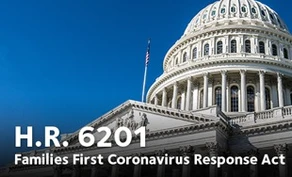Summary:
The federal government’s second major act in what is expected to be a series of initiatives to address the coronavirus (COVID-19) public health emergency.
Includes a range of provisions including free coronavirus testing, additional Medicaid funding, and nutrition assistance for low-income families. More details can be found here but aspects of the law that Ceterus believes will be most immediately relevant to our small business entrepreneurs are related to: Unemployment Benefits, Emergency Paid Sick Leave, and Expanded Family Medical Leave Act coverage.
Top of mind for small business entrepreneurs: the federal government is ultimately reimbursing the cost of these mandates via tax credits.
Ceterus finds this post from the US Chamber of Congress to be especially helpful as it relates to funding of new federal mandates for sick leave and FMLA.
For both sick leave and FMLA, employers subject to the requirements are entitled to a fully refundable tax credit. The tax credit is applied against employer Social Security taxes, but employers are reimbursed if their costs exceed the taxes they would owe. The Treasury Secretary is provided with regulatory authority intended to help with cash flow issues, for example by waiving penalties on failing to deposit payroll taxes in anticipation of the credit.
Tax credits will be increased by the amount of the expenses of the employer’s health care plan allocable to the qualified sick leave. This allows the employer to seek reimbursement for the cost of continuing to provide health insurance while the employee is on sick leave.
Which employers are covered by the mandate:
The bill applies to: employers with 500 or fewer employees.
Note that the law includes a hardship exemption for small businesses with fewer than 50 employees from the requirement of paying for sick leave if this would jeopardize the viability of the business as a going concern.
Ceterus believes that relevant federal agencies have yet to detail the mechanism by which an employer can apply for hardship exemption.
Unemployment Benefits
Unemployment insurance programs are administered at the State level so it’s difficult to speak generally to how this legislation and other recent government actions will apply generally. The federal government has granted relief to state agencies to provide flexibility (e.g., waiving waiting periods, extending coverage to employees who self-terminate employment to care for a family member, not requiring employees to demonstrate active job search activity to qualify for benefits).
Because President Trump declared a national emergency last week, those who lose work because of the virus may also qualify for Disaster Unemployment Assistance.
Employers and employees should check with their state department of labor for updates on this rapidly evolving landscape.
Emergency Paid Sick Leave
The new legislation requires private employers to provide paid sick leave to employees. Covered employers must give emergency paid sick time to any employee, regardless of the length of employment, for a qualifying emergency related to the coronavirus.
-
Full-time employees: 80 hours of emergency paid sick leave
-
Part-time employees: proportionately similar amount, based on the average number of hours they work in a two-week period.
Employee eligible where the employee is:
-
subject to a quarantine or isolation order
-
advised by a health care provider to self-quarantine
-
experiencing symptoms of COVID-19 and seeking a medical diagnosis;
-
caring for his or her son or daughter if the school or place of care has been closed or the child care provider is unavailable due to COVID-19 precautions; or
-
similar condition specified by the secretary of Health and Human Services in consultation with the secretary of the treasury and the secretary of labor
Maximum amount of pay during the leave will not exceed $511 per day ($5,110 aggregate) when sick leave is used for reasons (1)-(3) and will not exceed $200 per day ($2,000 in the aggregate) when used for reasons (4) or (5). Note that the tax credits are also limited to these amounts.
Employers who already provide sick leave may apply that existing sick leave to fulfill this mandate.
New Family Medical Leave Act (FMLA) Mandates
The FMLA is expanded to allow coverage for a new category: leave for a “qualifying need related to a public health emergency” with respect to COVID-19. This leave would only be available during the window of time beginning 15 days after the bill is enacted and ending on Dec. 31, 2020.
-
employee paid at a rate of pay that is “at least two-thirds of the regular rate” the employee would have earned under a normal work schedule.
-
an employee who has been employed for 30 calendar days is eligible for coverage.
-
coverage limitation to employees unable to work (or telework) due to a need for leave to care for the son or daughter of such employee if the school or place of care has been closed or the child care provider of such son or daughter is unavailable due to a public health emergency (more specifically COVID-19).
-
the initial 10 days are unpaid, unless an employee voluntarily elects to use existing accrued paid vacation leave, personal leave, or medical or sick leave to cover the unpaid leave. New “emergency paid sick leave” can be used.
The requirement to restore the employee to their position after the paid leave is taken do not apply to businesses with fewer than 25 employees if the position no longer exists because of the public health emergency (provided the employer takes certain actions to try and assist the employee).




